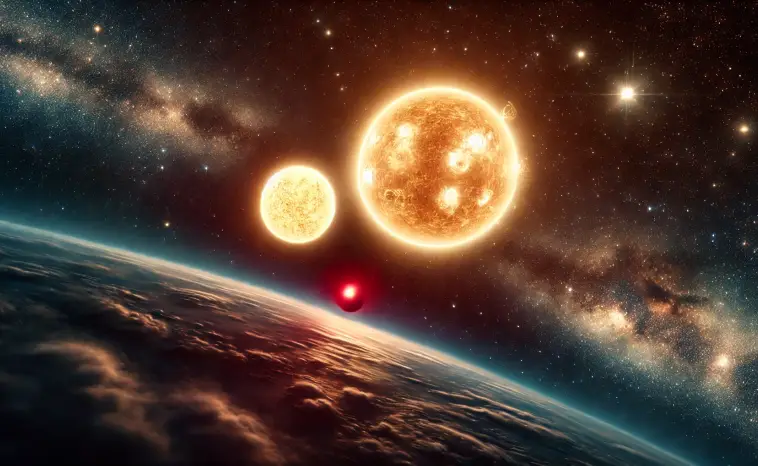The Nearest Stars to Earth – How Close Is Too Close?

Join us on a journey through space to learn about the nearest stars to Earth and how they shape our understanding of the universe!
Head outside on a clear night and take a glance skyward. Your reward? A dark canvas peppered with beautiful, inspiring, and simply mesmerising stars. But when those objects all look like tiny pinpricks of light, it’s easy to forget just how far away they are from us. What’s more, some are much closer to Earth than others! So, just how close are the nearest stars to Earth? Well, that’s what we’re going to explore today!
In this article, we’ll take a tour through our own corner of the galactic neighbourhood and discover the nearest stars to Earth.
The Sun: The Nearest Star to Earth

The Sun is, without question, the closest star to Earth. Sitting at an average distance of 93 million miles (150 million kilometres), it’s the source of life as we know it. Simply put, without the Sun’s light and heat, Earth would be a frozen, lifeless rock hurtling through space!
The Sun is a G-type main-sequence star, or a yellow dwarf. It’s an almost perfect sphere of hot plasma, composed primarily of hydrogen and helium, and accounts for 99.86% of the mass in our solar system. And with a surface temperature of around 5,500°C and a core that reaches over 15 million °C, it’s no wonder the Sun has such a profound influence on our planet.
93 million miles might sound like a pretty vast distance. But in astronomical terms, the Sun is practically right on our doorstep. Indeed, once we step beyond our solar system, the concept of “nearby” stars soon takes on a whole new meaning!
What Are the Nearest Stars to Earth Beyond the Sun?

After the Sun, the nearest star to Earth is Proxima Centauri, a red dwarf located in the Alpha Centauri star system. In the grand scheme of things, Proxima Centauri is basically the Sun’s next door neighbour, sitting a mere 4.24 light-years away. But just to put that into perspective a little, a single light-year is about 5.88 trillion miles (9.46 trillion kilometres)!
Proxima Centauri is much smaller and cooler than the Sun. It only has about 12% of the Sun’s mass and a surface temperature of around 3,000°C. That means that despite its proximity, Proxima Centauri isn’t visible to the naked eye from Earth due to its dimness. Still, its closeness has made it a subject of great interest for astronomers and space enthusiasts.
Proxima Centauri b: A Possible Second Earth?
Proxima Centauri isn’t travelling through the vast expanse of space all by its self. In fact, it has at least one confirmed exoplanet, Proxima Centauri b, and maybe even two more.
Proxima Centauri b is a rocky planet that lies within the star’s habitable zone. That means it’s at a distance where liquid water might just exist on its surface. And with a mass just slightly larger than Earth’s, Proxima Centauri b has certainly captured the imagination of scientists searching for extraterrestrial life.
That said, life needs more than just liquid water to thrive, and there’s a few potential spanners in the works that could impact the habitability of Proxima Centauri b. One of the biggest issues that life would need to overcome is the frequent and intense solar flares that Proxima Centauri sends its way. But despite the uncertainty, this exoplanet remains one of the most promising candidates for further study.
The Alpha Centauri System
Speaking of companions, Proxima Centauri isn’t alone when it comes to stars either. It’s part of the Alpha Centauri system, which also includes two Sun-like stars: Alpha Centauri A and Alpha Centauri B. These two stars form a binary system and are slightly farther away than Proxima Centauri, at about 4.37 light-years from Earth.
Alpha Centauri A and B are incredibly similar to our Sun in size and brightness. As a result, they’ve long been a source of fascination for both scientists and science fiction writers, many of whom have imagined the system as the first destination for interstellar travel. But while travelling such distances is well beyond our current capabilities, the Alpha Centauri system still offers a rich field for studying stars and planetary systems beyond our own.
Stars Beyond the Closest Neighbours
Proxima Centauri and Alpha Centauri definitely dominate the discussion on nearby stars. But they’re not the only ones in our stellar neighbourhood. Barnard’s Star, located six light-years away, is another red dwarf of interest. Slightly farther out, we find Sirius, the brightest star in the night sky, at a distance of 8.6 light-years.
Each of these stars provides us with unique opportunities for study. Whether it’s increasing our understanding of stellar lifecycles or searching for exoplanets, our nearest stars remind us that even our “local” cosmic environment is filled with diversity and wonder.
Final Thoughts on the Nearest Stars to Earth
From the Sun’s life-giving warmth to the just-around-the-corner mysteries of Proxima Centauri, the nearest stars to Earth offer endless opportunities for discovery. Our understanding of nearby stars like Proxima Centauri and the Alpha Centauri system is still in its infancy. Still, these stars stand as gateways to the universe beyond, inspiring scientific inquiry and our imagination alike.
Explore the Nearest Stars to Earth with the OSR Star Finder App

Curious to learn more about the stars near and far? Check out the OSR Star Finder App for an interactive guide to the cosmos. Whether you’re a seasoned astronomer or a curious stargazer, it’s the perfect tool to deepen your connection with the night sky!

